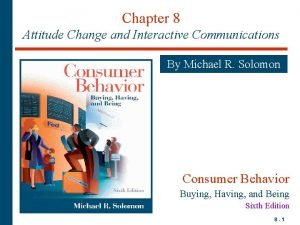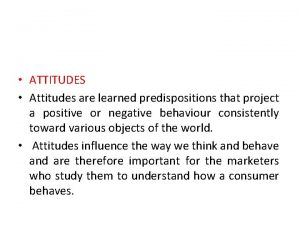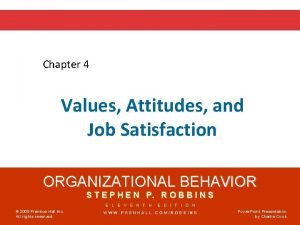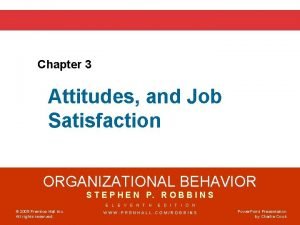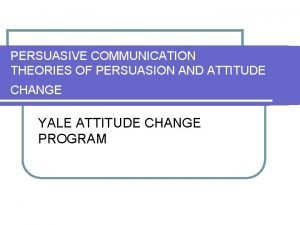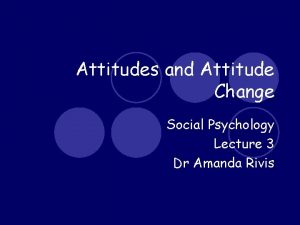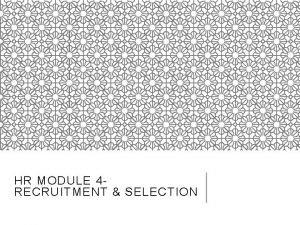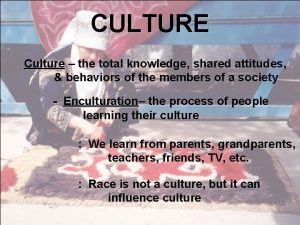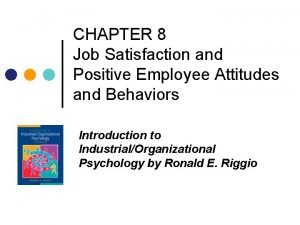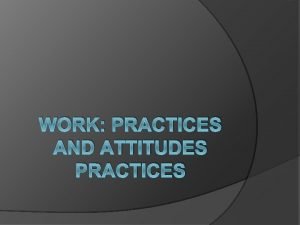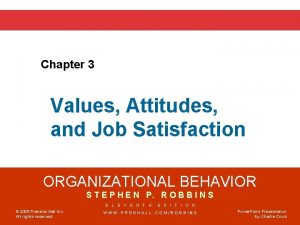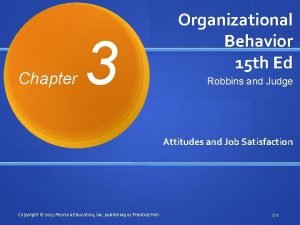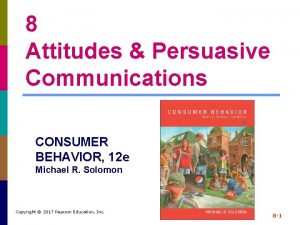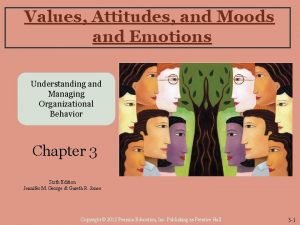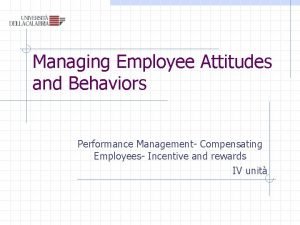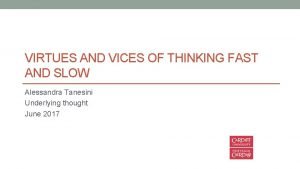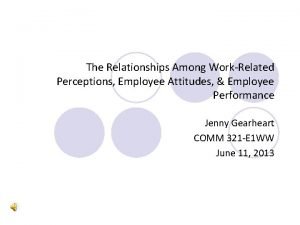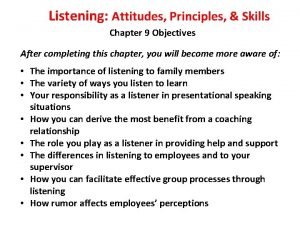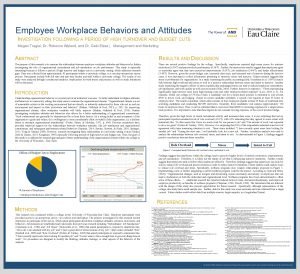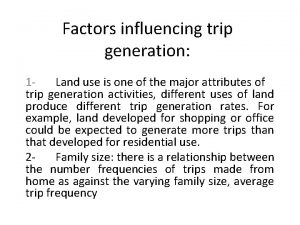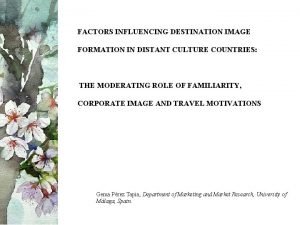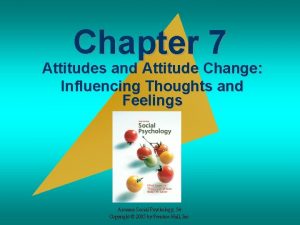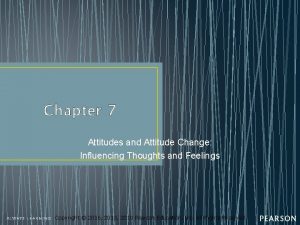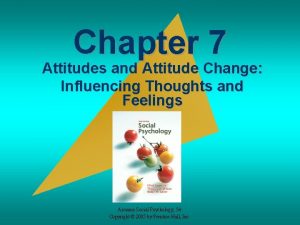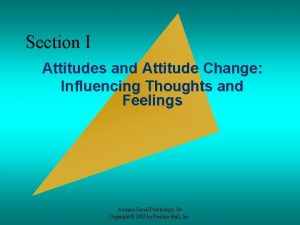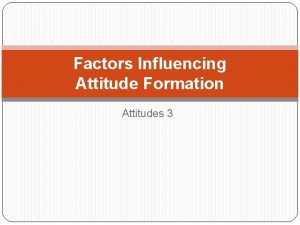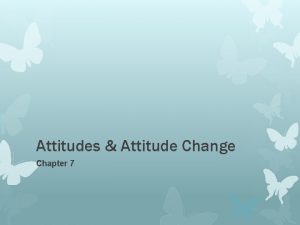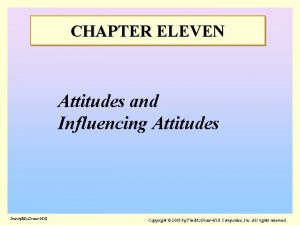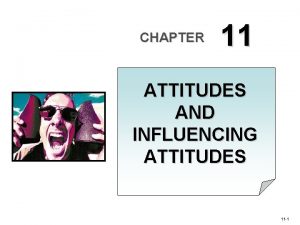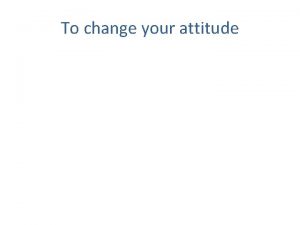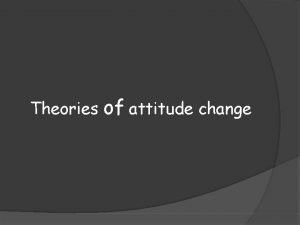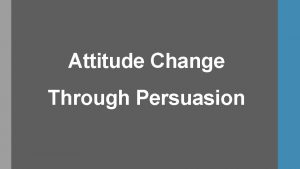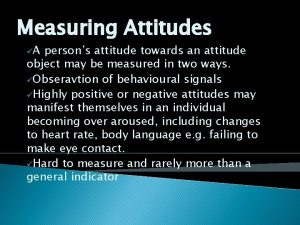Chapter 7 Attitudes and Attitude Change Influencing Thoughts






























































- Slides: 62

Chapter 7 Attitudes and Attitude Change: Influencing Thoughts and Feelings © 2004 Pearson Education Canada Inc.

Chapter Outline I. The Nature and Origin of Attitudes © 2004 Pearson Education Canada Inc.

The Nature and Origin of Attitudes An attitude is a person’s evaluation, positive or negative, of a person, object, or idea. All attitudes have affective, cognitive, and behavioural components. Attitudes can be based more on one component than another. © 2004 Pearson Education Canada Inc.

The Nature and Origin of Attitudes Where do Attitudes Come From? Cognitive Component Cognitively based attitudes are based primarily on a person’s beliefs about the properties of the attitude object. The purpose of the attitude is to evaluate the object so that we can tell quickly whether it is worth our while to have anything to do with it. © 2004 Pearson Education Canada Inc.

The Nature and Origin of Attitudes Where do Attitudes Come From? Affective Component Affectively based attitudes are based more on people’s feelings and values pertaining to the attitude object. Affectively based attitudes come from a variety of sources: i. They stem from people’s values, such as religious or moral beliefs, e. g. , abortion , death penalty, premarital sex. © 2004 Pearson Education Canada Inc.

The Nature and Origin of Attitudes Where do Attitudes Come From? Affective Component Affectively based attitudes come from a variety of sources: (cont’d) ii. Sensory reaction, i. e. , liking the taste of chocolate iii. Conditioning, both classical conditioning (e. g. , Pavlov’s dog) and operant conditioning (Skinner’s reinforcement). (See Fig. 7. 1. ) © 2004 Pearson Education Canada Inc.

The Nature and Origin of Attitudes Where do Attitudes Come From? Affective Component Conditioning definitions: Classical conditioning is the case whereby a stimulus that elicits an emotional response is repeatedly experienced along with a neutral stimulus that does not, until the neutral stimulus takes on the emotional properties of the first stimulus. Operant conditioning refers to behaviours that people freely choose to perform increase or decrease in frequency, depending on whether they are followed by positive reinforcement or punishment. © 2004 Pearson Education Canada Inc.

© 2004 Pearson Education Canada Inc.

The Nature and Origin of Attitudes Where do Attitudes Come From? behavioural Component behaviourally based attitudes are based on selfperceptions of one’s own behaviour toward an attitude object, e. g. , I guess I like running; I’m always doing it. But, people infer attitudes from behaviour only under certain conditions: • The initial attitude must be weak, or ambiguous • There are no other plausible explanations for their behaviour © 2004 Pearson Education Canada Inc.

The Nature and Origin of Attitudes Comparing Affective, Cognitive, and behavioural Bases of Attitudes Different attitudes have different bases. Attitudes towards different social groups (e. g. , homosexuals) we dislike are likely to have a cognitive basis, especially if we feel threatened. Attitudes towards groups whom we like (e. g. , English or French Canadians) are more likely to based on affect. © 2004 Pearson Education Canada Inc.

The Nature and Origin of Attitudes Comparing Affective, Cognitive, and behavioural Bases of Attitudes Different bases (cont’d) Attitudes toward issues such as capital punishment also are more likely to be based on affect; -ie, how we feel about it rather than what we think about it (see Zanna & colleagues 1993, 1994, 1998). © 2004 Pearson Education Canada Inc.

The Nature and Origin of Attitudes Determinants of Attitude Strength Attitudes differ in strength, and strongly held attitudes are more resistant to change. There are four major determinants of whether an attitude is strong or weak: • Ambivalence • Accessibility • Subjective experiences • Autobiographical recall © 2004 Pearson Education Canada Inc.

The Nature and Origin of Attitudes Determinants of Attitude Strength Ambivalence: Sometimes we experience ambivalence, or mixed feelings towards someone, or something. Ambivalent attitudes are weaker, and more easily changed than attitudes that are clearly positive or clearly negative. © 2004 Pearson Education Canada Inc.

The Nature and Origin of Attitudes Determinants of Attitude Strength Accessibility is the strength of the association between an object and a person’s evaluation of that object. Accessibility is measured by the speed with which people can report how they feel about an issue or object (see mountain bike example). Studies show that attitudes that are highly accessible are strong and harder to change. © 2004 Pearson Education Canada Inc.

The Nature and Origin of Attitudes Determinants of Attitude Strength ‘Subjective experience’ refers to the ease with which we can generate arguments for or against our attitude. A greater number of supportive arguments indicates greater attitude strength (see Haddock et al, 1996 study). Autobiographical Recall: Our attitudes are stronger if we recall personal behaviours relevant to that attitude (see Zanna and colleagues’ toothbrush study). © 2004 Pearson Education Canada Inc.

When Will Attitudes Predict Behaviour? Advertisers assume that changing people’s attitudes toward products will result in increased sales. Politicians assume that positive feelings toward a candidate will result in a vote for that candidate. To what extent are the above assumptions true? © 2004 Pearson Education Canada Inc.

When Will Attitudes Predict Behaviour? Studies show that there is not a direct relationship between attitudes and behaviour. The relationship is much more complex (see the La. Piere, 1934, Chinese couple study). Indeed, an early review of studies of attitudebehaviour relationship concluded that people’s attitudes are poor predictors of their behaviour (see Wicker, 1969). But, later research indicated that attitudes can predict behaviour quite well under certain circumstances (see Fazio, 1990). © 2004 Pearson Education Canada Inc.

When Will Attitudes Predict Behaviour? Predicting Spontaneous Behaviour Sometimes we act spontaneously, giving little thought to what we are about to do. Under these circumstances we rely on accessibility of attitudes to guide us, and highly accessible attitudes predict behaviour quite well (see Fazio et al, 1989, consumer products study). If the attitudes are not highly accessible, arbitrary aspects of the situation (e. g. , location of items on the table) will tend to determine behaviour. © 2004 Pearson Education Canada Inc.

When Will Attitudes Predict Behaviour? Predicting Deliberative Behaviours; Fishbein & Ajzen Theory At other times behaviour is not spontaneous, but is deliberative and planned. The best-known theory of how attitudes predict deliberative behaviours is Ajzen & Fishbein’s theory of planned behaviour. Fishbein and Ajzen’s theory of planned behaviour is a theory of how attitudes predict planned, deliberative behaviour (Fig. 7. 2). © 2004 Pearson Education Canada Inc.

When Will Attitudes Predict Behaviour? Predicting Deliberative Behaviours; Fishbein & Ajzen Theory Specific attitudes are better predictors of behaviour than are general attitudes (see Davidson & Jaccard, 1979 birth control study; Table 7. 1). Subjective norms: people’s beliefs about how those they care about will view the behaviour in question. Perceived behavioural control: refers to the extent to which people believe they can perform the behaviour. © 2004 Pearson Education Canada Inc.

When Will Attitudes Predict Behaviour? Predicting Deliberative Behaviours; Fishbein & Ajzen Theory Research shows that consideration of these variables increases the ability to predict people’s planned, deliberative behaviours (see Mummery & Wankel, 1999, swimmer study). Fishbein and Ajzen’s theory has also been useful in predicting other behaviours: -smoking among Quebec high school students; -exercise among Albertans being treated for cancer; -exercise and smoking among Quebec men; -exercise for the©elderly. 2004 Pearson Education Canada Inc.

When Will Attitudes Predict Behaviour? Predicting Deliberative Behaviours; Fishbein & Ajzen Theory Two recent meta analyses indicate that attitudes and perceived behavioural control are more important than subjective norms in predicting behavioural intentions (e. g. , health and exercise behaviours). Thus, when it comes to health and exercise behaviours, it may be more important to have positive attitudes and believe that you are able to perform the necessary behaviours than to feel that your friends and family want you to eat well and be fit. © 2004 Pearson Education Canada Inc.

When Will Attitudes Predict Behaviour? Attitude-Behaviour Consistency: Implications for Safe Sex One area in which people’s attitudes are often inconsistent with their behaviour, even though the consequences may be fatal, is condom use, i. e. , students agree that condoms should be used, but a low percentage actually use them when engaging in casual sex. Why? The theory of planned behaviour may provide an explanation. Let’s look at the three variables, i) subjective norms, ii( perceived control, and ii) behavioural intentions. © 2004 Pearson Education Canada Inc.

When Will Attitudes Predict Behaviour? Attitude-Behaviour Consistency: Implications for Safe Sex Subjective norms. People’s beliefs about how others view the behaviour in question are an important determinant of their behaviour. On the positive side, two-thirds of students at a high school in Nova Scotia believe that their sexually active friends use condoms. © 2004 Pearson Education Canada Inc.

When Will Attitudes Predict Behaviour? Attitude-Behaviour Consistency: Implications for Safe Sex Subjective norms (cont’d) On the negative side, when people are in an environment where unprotected sexual activity is condoned (e. g. , break loose vacations), or if they anticipate a negative reaction from their partner, they will be less likely to use condoms. © 2004 Pearson Education Canada Inc.

When Will Attitudes Predict Behaviour? Attitude-Behaviour Consistency: Implications for Safe Sex Subjective norms, negative side (cont’d) And, women are concerned that if they provide condoms, they will be perceived as someone who engages in casual sex__something that nice women don’t do. Thus, if people anticipate that their sexual partner would not approve of condom use, they are more likely to engage in unprotected sex. © 2004 Pearson Education Canada Inc.

When Will Attitudes Predict Behaviour? Attitude-Behaviour Consistency: Implications for Safe Sex Perceived control: when people are not comfortable purchasing condoms, or bringing up the issue of condom use with their partner, they will be less likely to use condoms. © 2004 Pearson Education Canada Inc.

When Will Attitudes Predict Behaviour? Attitude-Behaviour Consistency: Implications for Safe Sex behavioural intentions: when people’s intentions to use condoms are undermined (e. g. , due to intoxication) they will be less likely to use condoms. Another variable that can influence people’s intentions to use a condom is mood. Studies show that female students in a bad mood are more likely to have unprotected sex than students in a good mood, especially if those in a bad mood also had low self-esteem. © 2004 Pearson Education Canada Inc.

Chapter Outline II. Attitude Change © 2004 Pearson Education Canada Inc.

Attitude Change Persuasive Communications and Attitude Change Attitudes do sometimes change; when they do it is usually in response to social influence. Psychologists have conducted many studies over the year on what makes a persuasive communication effective, beginning with Hovland (1953). Since he was at Yale University, this body of research was known as the Yale approach. Persuasive communication: communication (e. g. , a speech or TV ad) advocating a particular side of an issue. © 2004 Pearson Education Canada Inc.

Attitude Change Persuasive Communications and Attitude Change Yale Attitude Change Approach: a study of the conditions under which people are most likely to change their attitudes in response to persuasive messages. Researchers in this tradition focus on ‘who said what to whom’, i. e. , on the source of the communication, the nature of the communication, and the nature of the audience. © 2004 Pearson Education Canada Inc.

Attitude Change Persuasive Communications and Attitude Change The Yale approach yielded a great deal of useful information on how people change their attitudes in response to persuasive communications (Fig. 7. 3). However, it is not clear as yet which aspects of persuasive communications are most important, i. e. , when one factor should be emphasized over another (“Should I worry most about who delivers the message? Or should I worry more about the content of the message? ”) © 2004 Pearson Education Canada Inc.

© 2004 Pearson Education Canada Inc.

Attitude Change Persuasive Communications and Attitude Change: The Central & Peripheral Routes Two influential theories, Chaiken’s heuristicsystematic persuasion model, and Petty and Cacioppo’s elaboration likelihood model, have tried to specify when people will be more influenced by message content and when they will be more influenced by superficial characteristics of the message. © 2004 Pearson Education Canada Inc.

Attitude Change Persuasive Communications and Attitude Change : The Central & Peripheral Routes Heuristic-systematic model of persuasion: theory that there are two ways in which persuasive communications can cause attitude change: people either i) process the merits of the arguments, known as systematic processing, or ii) use mental shortcuts (heuristics) such as “Experts are always right”, known as heuristic processing. © 2004 Pearson Education Canada Inc.

Attitude Change Persuasive Communications and Attitude Change: The Central & Peripheral Routes Elaboration likelihood model: theory that there are two ways in which persuasive communications can cause attitude change: i) the central route occurs when people are motivated and have the ability to pay attention to the arguments in the communication (see Fig. 7. 4) ii) the peripheral route occurs when people do not pay attention to the arguments but are instead swayed by surface characteristics (e. g. , who gave the speech). © 2004 Pearson Education Canada Inc.

© 2004 Pearson Education Canada Inc.

Attitude Change Persuasive Communications and Attitude Change: The Central & Peripheral Routes What determines whether a person will take the central vs the peripheral route to persuasion? The key, according to both theorists, Petty & Chaiken, is whether people have the motivation and ability to pay attention to the facts. People who are interested, motivated, and have the ability to pay attention to the arguments are more likely to take the central route (see Figure 7. 4). © 2004 Pearson Education Canada Inc.

Attitude Change Persuasive Communications and Attitude Change: Motivation to Attend to Arguments One determinant of whether people are motivated to pay attention to a communication is the personal relevance of the topic ie, the extent to which a topic has important consequences for a person’s well-being (eg, student fees, pension benefits). The more personally relevant an issue is, the more willing people are to pay attention to the arguments in a speech, and thus more likely to take the central route to persuasion (see Chaiken, 1980; Fig. 7. 5). © 2004 Pearson Education Canada Inc.

© 2004 Pearson Education Canada Inc.

Attitude Change Persuasive Communications and Attitude Change: Motivation to Attend to Arguments Thus, when an issue is personally relevant, people will pay attention to the arguments of the speech and will be persuaded to the extent that the arguments are sound (central route to persuasion). When an issue is of low personal relevance people will not pay as close attention to the arguments. Instead, they will take a mental shortcut, following such peripheral rules as ‘Prestigious speakers can be trusted. ’ (Peripheral route) © 2004 Pearson Education Canada Inc.

Attitude Change Persuasive Communications and Attitude Change: Motivation to Attend to Arguments People’s motivation to listen carefully to message content also depends on their personality, their need for cognition. Need for Cognition: a personality variable reflecting the extent to which people engage in and enjoy effortful cognitive activities. © 2004 Pearson Education Canada Inc.

Attitude Change Persuasive Communications and Attitude Change: Motivation to Attend to Arguments People high in need for cognition are more likely to form attitudes by paying close attention to relevant arguments (central route), whereas people low in the need for cognition rely on peripheral cues when forming attitudes. © 2004 Pearson Education Canada Inc.

Attitude Change Persuasive Communications and Attitude Change: Ability to Pay Attention The route to attitude change also depends on people’s ability to pay attention to, and to understand the arguments. The more distracted people are, or the more difficult it is for them to understand the arguments, the more likely it is that they will take the peripheral route (see Hafer et al, 1996, Karla Homolka study). © 2004 Pearson Education Canada Inc.

Attitude Change Persuasive Communications and Attitude Change: Mood When people are in a positive mood, persuasion is more likely to occur via the peripheral route; they are less likely to analyze a message carefully than when they are in a negative mood. They want to preserve the good mood so they will avoid any activity that might spoil it. People in a sad, or neutral mood are more likely to take the central route, to analyze each argument in detail (see Schwarz & Strack, 1990 study; Fig. 7. 6). © 2004 Pearson Education Canada Inc.

Attitude Change Persuasive Communications and Attitude Change: The Importance of Central Processing Why is central processing so important in attitude formation? Because, people who base their attitudes on a careful analysis of the arguments are: • more likely to maintain this attitude over time • more likely to behave consistently with this attitude • more resistant to counter-persuasion than people who base their attitudes on peripheral cues. © 2004 Pearson Education Canada Inc.

Attitude Change Fear and Attitude Change Another approach to changing attitudes is to use fear. Indeed, this is one of the most common procedures used in the mass media. Do such fear-arousing communications work? It depends. Too little, or too much fear is not effective. Moderate fear, along with instructions detailing how to go about changing the undesirable behaviour (with a bit of humor) is the best strategy for producing significant change in behaviour © 2004 Pearson Education Canada Inc.

Attitude Change Advertising and Attitude Change People think that advertising works on everyone but themselves. The truth is advertising works on everybody given the right circumstances. Studies show that when a product is advertised sales increase. But, what type of ads work best? It depends on the basis of the attitude. © 2004 Pearson Education Canada Inc.

Attitude Change Tailoring Advertisements to People’s Attitudes The type of ad that works best depends on the basis of the attitude. If the attitude is cognitively based, change it with rational arguments and personal relevance (eg, heartburn); if it is affectively based, change it with important emotions and values (eg, long-distance call to longlost brother). © 2004 Pearson Education Canada Inc.

Attitude Change Tailoring Advertisements to People’s Attitudes If people’s attitudes are cognitively based, then advertisers need to deal with an additional issue— personal relevance of their product. They need to make the product personally relevant for the ad to be effective (see Listerine example). These campaigns work by convincing people they have problems of great personal relevance and that the advertised product can solve these problems. © 2004 Pearson Education Canada Inc.

Attitude Change Tailoring Advertisements to People’s Attitudes Many ads try to make people’s attitudes more affectively based by associating the product with important emotions and values (see long-distance telephone service example). By associating positive emotions with a product, an advertiser can turn a bland product into one that evokes feelings of nostalgia, love, warmth, and general goodwill. Studies show that people react more favourably to the ads that match the type of attitude they hold (see Shavitt, 1990; Fig. 7. 7). © 2004 Pearson Education Canada Inc.

Attitude Change Negative Advertising and Attitude Change Negative Advertising: Does it work? Another approach to advertising is to slam the opposition. How effective is this? Not very, at least where politics is concerned (Rose & Sande, 1993) In one study, negative advertising produced the opposite effect to that desired (see Haddock & Zanna, 1997 Canadian federal election study). © 2004 Pearson Education Canada Inc.

Attitude Change Cultural Differences in Advertising Western cultures stress independence and individualism, whereas Asian cultures stress interdependence. One might expect that ads that reflect these differences would work better in their respective cultures. Research supports this hypothesis. American ads emphasized individuality and self-improvement, whereas Korean ads emphasized family and the social group (see Han & Shavitt, 1994). © 2004 Pearson Education Canada Inc.

Attitude Change Subliminal Advertising A majority of the public believes that subliminal messages can unknowingly shape attitudes and behaviours. Subliminal messages are words or pictures that are not consciously perceived but that supposedly influence people’s judgments, attitudes, and behaviours. © 2004 Pearson Education Canada Inc.

Attitude Change Subliminal Advertising Subliminal messages are purported to help people lose weight, stop smoking, improve their study habits, raise their self-esteem, even take a few strokes off their golf score. How effective are subliminal messages in changing people’s attitudes and behaviour? Not at all in everyday life. People think that messages are effective, but there is no evidence of this. © 2004 Pearson Education Canada Inc.

Attitude Change Subliminal Advertising There is some evidence, however, for the effectiveness of subliminal messages from carefully controlled lab studies (see Baldwin et al, 1990, selfevaluations). But, all the successful demonstrations of subliminal stimuli have been conducted under meticulous lab conditions that are difficult to reproduce in everyday life. © 2004 Pearson Education Canada Inc.

Chapter Outline III. How to Make People Resistant to Attitude Change © 2004 Pearson Education Canada Inc.

How to Make People Resistant to Attitude Change Attitude Inoculation How do we resist the multitude of persuasive messages that bombard us everyday? One way to bolster people against persuasion attempts is to have them consider the arguments for and against their attitude before somebody attacks it. This is known as attitude inoculation (Mc. Guire, 1964). © 2004 Pearson Education Canada Inc.

How to Make People Resistant to Attitude Change Attitude Inoculation Attitude inoculation: the process of making people immune to attempts to change their attitudes by initially exposing them to small doses of the arguments against their position. Those who are inoculated with weak arguments have the opportunity to think about why these arguments are unfounded and are in a better position to contradict the stronger arguments. Is this effective? Yes (Mc. Guire, 1964) © 2004 Pearson Education Canada Inc.

How to Make People Resistant to Attitude Change Resisting Peer Pressure Many attacks on our attitudes consist of appeals to our emotions by our peers (eg, ‘come and have a cigarette, don’t be a wimp. ’) Can we inoculate ourselves against such social pressures by exposing ourselves to mild pressures and learning how to cope with them? Yes (see Mc. Alister et al, 1980 smoking prevention study with 7 th graders). These researchers found that these students were less likely to smoke three years after the study, compared to a control group that had not participated in the program. © 2004 Pearson Education Canada Inc.

How to Make People Resistant to Attitude Change When Persuasion Attempts Boomerang: Reactance Theory It is important not to use too heavy a hand when trying to immunize people against assaults on their attitudes. If you administer too strong a prohibition, the prohibition may boomerang and lead to an increase in the prohibited activity (see Reactance theory). © 2004 Pearson Education Canada Inc.

How to Make People Resistant to Attitude Change When Persuasion Attempts Boomerang: Reactance Theory Reactance theory: the idea that when people feel their freedom to perform a certain behaviour is threatened, an unpleasant state of reactance is aroused. People become more likely to perform the undesired behaviour following strong admonitions (eg Don’t smoke, or else) in an attempt to restore their sense of personal freedom and choice. The End © 2004 Pearson Education Canada Inc.
 I am not my thoughts
I am not my thoughts Elm model
Elm model Types of attitude
Types of attitude Attitude and value change
Attitude and value change Values attitudes and job satisfaction
Values attitudes and job satisfaction Organizational behavior chapter 3
Organizational behavior chapter 3 What is the yale attitude change approach
What is the yale attitude change approach Petty and cacioppo's model of persuasion
Petty and cacioppo's model of persuasion Physical change
Physical change Absolute change and relative change formula
Absolute change and relative change formula Difference between a chemical and physical change
Difference between a chemical and physical change Change in supply and change in quantity supplied
Change in supply and change in quantity supplied Chemical change and physical change
Chemical change and physical change Rocks change due to temperature and pressure change
Rocks change due to temperature and pressure change Physical change vs chemical change venn diagram
Physical change vs chemical change venn diagram First-order change
First-order change Emerson efficiency plan formula
Emerson efficiency plan formula Pull influencing style
Pull influencing style Factors influencing recruitment and selection
Factors influencing recruitment and selection Group polarization vs groupthink
Group polarization vs groupthink New zealand attitudes and values study
New zealand attitudes and values study Obvious ways values enter psychology
Obvious ways values enter psychology Quality culture
Quality culture Attitudes and movements
Attitudes and movements The total knowledge shared attitudes and behaviors
The total knowledge shared attitudes and behaviors Positive employee attitudes and behaviors
Positive employee attitudes and behaviors Workplace emotions attitudes and stress
Workplace emotions attitudes and stress Work practices and attitudes
Work practices and attitudes Training is the act of increasing the
Training is the act of increasing the Workplace emotions, attitudes, and stress
Workplace emotions, attitudes, and stress Values and attitudes in the workplace
Values and attitudes in the workplace Values attitudes and job satisfaction
Values attitudes and job satisfaction 5 unsafe attitudes and consequences
5 unsafe attitudes and consequences Avenues of communication
Avenues of communication Compare and contrast the major job attitudes
Compare and contrast the major job attitudes Attitudes and persuasive communications
Attitudes and persuasive communications Emotions and attitudes in a workplace
Emotions and attitudes in a workplace Managing employee attitudes and behaviors
Managing employee attitudes and behaviors Virtues and vices are attitudes. what are their objects?
Virtues and vices are attitudes. what are their objects? Hpliooshyp basic beliefs, concepts, and attitudes
Hpliooshyp basic beliefs, concepts, and attitudes Employee attitudes and employee performance
Employee attitudes and employee performance Mughal dynasty
Mughal dynasty Listening attitudes principles and skills
Listening attitudes principles and skills Habits and attitudes
Habits and attitudes Workplace behaviors and attitudes
Workplace behaviors and attitudes Is painting a wall a physical change
Is painting a wall a physical change Define integers
Define integers Input and output markets
Input and output markets Change your water change your life
Change your water change your life Proactive and reactive change
Proactive and reactive change Spare change physical versus chemical change
Spare change physical versus chemical change Physical change
Physical change How does a physical change differ from a chemical change?
How does a physical change differ from a chemical change? Is chopping wood a chemical or physical change
Is chopping wood a chemical or physical change Climate change 2014 mitigation of climate change
Climate change 2014 mitigation of climate change Physique and chemique are
Physique and chemique are Oxidation weathering diagram
Oxidation weathering diagram Physical factors influencing agriculture
Physical factors influencing agriculture What is the shape of the trajectory of a projectile? *
What is the shape of the trajectory of a projectile? * Contemporary nursing meaning
Contemporary nursing meaning Factors affecting trip generation
Factors affecting trip generation External factors influencing pricing decisions
External factors influencing pricing decisions Factors influencing destination image
Factors influencing destination image

